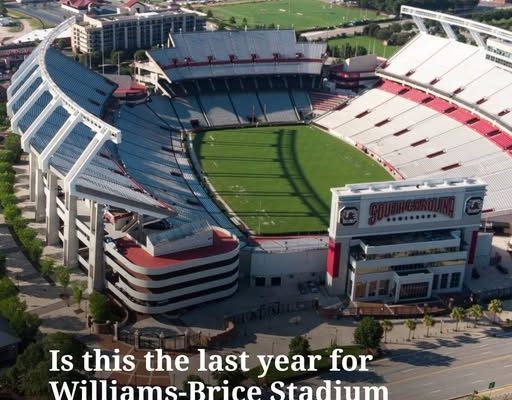In the heart of Columbia, South Carolina, an ambitious race against time is unfolding. The University of South Carolina’s athletic department has embarked on one of its most aggressive and high-stakes projects in modern history: a transformative renovation of Williams-Brice Stadium. With only 281 days separating the Gamecocks’ 2025 home finale against archrival Clemson and their highly anticipated 2026 season opener against the Miami Hurricanes, the university’s leadership is determined to reimagine the entire gameday experience for fans, boosters, and players alike. The stakes are high — the Gamecocks have not only set their sights on revitalizing the stadium’s infrastructure but also on fundamentally changing the revenue dynamics that fuel the football program.
For decades, Williams-Brice Stadium has been a centerpiece of Gamecock football culture, a coliseum where roaring fans and electric atmospheres have defined autumn Saturdays in Columbia. But as the college football arms race intensifies, with Southeastern Conference (SEC) peers like Alabama, Georgia, LSU, and Texas A&M investing heavily in stadium upgrades, the Gamecocks have faced mounting pressure to modernize. A glaring weakness has been the lack of premium seating options — particularly luxury suites and club areas. At present, Williams-Brice offers just 18 suites, the lowest in the SEC, severely limiting the program’s ability to maximize revenue from corporate sponsors, high-end ticket holders, and hospitality packages.
The new renovation plan, announced with bold enthusiasm by athletic director Ray Tanner and university president Michael Amiridis, is set to triple the number of suites from 18 to 43 by 2027. This aggressive expansion of premium seating, coupled with a complete overhaul of existing club areas, is projected to generate millions of additional dollars annually. The university estimates that the enhanced premium experience will not only offset the construction costs but will also provide long-term financial stability for the athletic department, funding everything from recruiting budgets to facility upgrades for other sports.
However, the most challenging aspect of this project is the timeline. Unlike some stadiums that undergo renovations during extended offseasons or over multiple years, South Carolina’s leadership has opted for a compressed schedule that must align with the football calendar. Once the final whistle blows in the 2025 home finale against Clemson, construction crews will have less than 300 days — specifically, 281 days — to implement the first phase of the renovation before fans arrive for the season opener against Miami. The decision to target such an aggressive timeline reflects both the urgency of the upgrades and the university’s commitment to minimizing disruptions to the fan experience.
The renovation will not be limited to luxury areas. Early design blueprints reveal a reimagined concourse experience, with widened pedestrian pathways, improved signage, upgraded concessions, and state-of-the-art video boards. The seating bowl is also expected to undergo adjustments, ensuring that the new premium areas are seamlessly integrated without detracting from the capacity and energy that make Williams-Brice one of the SEC’s most intimidating venues. University officials have made it clear: the Gamecocks want to strike a balance between modernization and preserving the authentic, rowdy atmosphere that fans have come to cherish.
Ray Tanner has been at the forefront of communicating this vision to fans and donors. In a recent press conference, Tanner emphasized that the renovation is not just about aesthetics or luxury — it’s about positioning South Carolina football for sustained success in a hypercompetitive landscape. “Our fans deserve a first-class gameday experience, and our program deserves the resources that come from having a state-of-the-art stadium,” Tanner remarked. “Williams-Brice has always been a special place, but this renovation will allow us to compete with anyone in the SEC in terms of facilities and fan amenities. We know the timeline is tight, but we have the right partners and the right plan to get it done.”
The “right partners” Tanner refers to include a coalition of construction firms, architectural design teams, and project management specialists who have been handpicked for their experience with large-scale stadium projects. Firms that have previously worked on renovations at venues like Texas A&M’s Kyle Field and LSU’s Tiger Stadium have been consulted to ensure that South Carolina’s approach is both efficient and innovative. The university has also engaged with fan focus groups and alumni to gather input on the types of amenities and experiences they want to see integrated into the new design. From upscale dining options in the club levels to high-speed Wi-Fi connectivity throughout the stadium, no detail has been left unexamined.
A particularly exciting element of the renovation is the creation of new club lounges that will cater to different segments of the fan base. These lounges will feature modern interiors, private restrooms, and exclusive viewing areas, elevating the hospitality experience to rival that of NFL stadiums. Additionally, the increase in suite inventory — jumping from 18 to 43 — will allow the Gamecocks to offer premium packages that appeal to corporate partners, local businesses, and high-net-worth individuals who see value in hosting clients or celebrating game day in style. This shift toward premium experiences is not just about luxury — it’s a financial necessity in the modern era of college athletics.
Over the past decade, college football programs have increasingly relied on premium seating revenue to offset rising costs associated with coaching salaries, recruiting travel, and NIL (Name, Image, and Likeness) initiatives. Programs like Alabama and Georgia have demonstrated that investing in luxury seating pays significant dividends, often funding other athletic programs and ensuring competitive balance in recruiting wars. South Carolina’s move to upgrade Williams-Brice is as much about keeping pace with these trends as it is about creating a new experience for fans.
The financial implications of the renovation are staggering but carefully calculated. Preliminary projections suggest that the new suite and club inventory could generate between $10 million and $15 million in annual revenue once fully operational. This would represent a substantial boost compared to the current premium seating revenue, which has lagged behind SEC counterparts. Furthermore, the university is exploring long-term naming rights deals and sponsorship agreements tied to the renovated sections, which could provide additional funding streams. These revenue sources are critical as the Gamecocks look to not only compete in football but also sustain successful programs in baseball, basketball, and women’s sports.
The fan reaction to the renovation announcement has been overwhelmingly positive, though some concerns remain. Season ticket holders have expressed curiosity about how the upgrades will affect pricing and seating arrangements, particularly in the lower bowl and student sections. University officials have pledged to maintain affordability for general seating while offering new pricing tiers for premium experiences. “We’re not taking away the passion of the 80,000 fans who make Williams-Brice electric,” Tanner reassured. “Our goal is to enhance that energy, not replace it.”
Beyond the financial and logistical challenges, there is also a cultural dimension to this renovation. Williams-Brice Stadium has long been known for its raucous student section, the iconic “Sandstorm” tradition, and a gameday atmosphere that blends Southern hospitality with unbridled intensity. Preserving this culture while adding modern amenities will require careful planning. For instance, new sound and lighting systems are being designed to complement the traditions rather than overshadow them. Similarly, the new club spaces will feature nods to Gamecock history, ensuring that fans feel a sense of continuity even as they enjoy new levels of comfort.
As the clock ticks toward the 2026 opener, construction planning is already in high gear. The project will be divided into multiple phases, with the initial phase focusing on demolishing outdated sections, reinforcing the stadium’s structural integrity, and building the framework for the expanded suites. Subsequent phases, extending into 2027, will complete the club areas, upgrade concessions, and integrate new technology. By the time the final phase wraps up, Williams-Brice Stadium is expected to emerge as a venue that not only rivals the best in college football but also serves as a benchmark for future stadium designs in the SEC.
The season opener against Miami in 2026 has already been hyped as a symbolic debut for the “new” Williams-Brice. Fans, alumni, and media outlets are expected to descend on Columbia, eager to see how the renovation has reshaped the gameday experience. For the players and coaching staff, the upgraded facilities will serve as both a recruiting tool and a source of pride, reflecting the university’s commitment to building a championship-caliber program.



